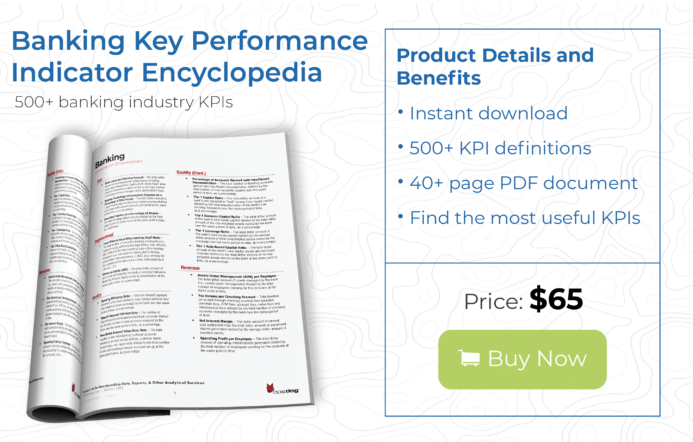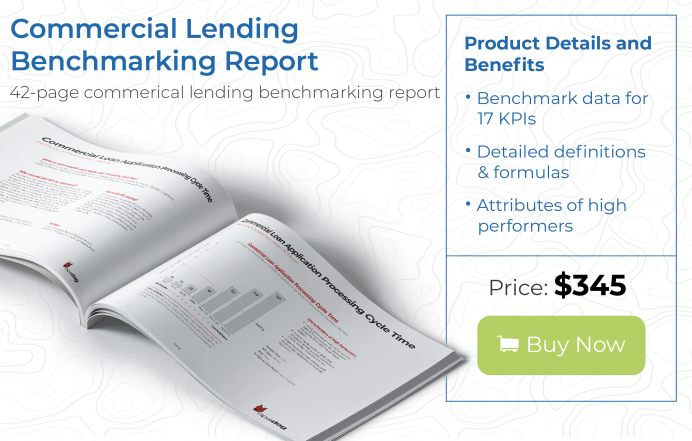Businesses large and small often turn to commercial banks to fund their capital needs, help them manage cash flow, and provide access to basic financial products such as checking and savings accounts and certificates of deposit. While commercial banks handle a wide range of business needs, their bread and butter are typically making commercial loans and one of the best ways to boost the performance of lenders is by tracking commercial bank key performance indicators.
What are Commercial Banking Key Performance Indicators?
Although they are both depository institutions, retail banks deal with consumers while commercial banks offer financial services to small businesses, corporations, government entities, or even other banks. Most banks have a retail business as well as a commercial business, but the commercial business is usually managed differently than the retail side of the bank.
This is because retail customers and business customers have different needs and expectations, the two lines of business operate separately, with different processes, organizational hierarchies, and revenue and profit goals. And, with different key performance indicators (KPIs) driving their operational goals.
Commercial bank key performance indicators are more than just simple metrics. While a metric measures a specific process—such as how many commercial loans a lender rejects—KPIs turn those metrics into measurements of success. Commercial bank key performance indicators can be defined as a measurement that can indicate whether the performance of a commercial bank, a lending process, or even an individual employee is meeting strategic business goals and how the bank is comparing to its peers.
For example, commercial loans tend to be more complex and for higher loan amounts than consumer loans. There’s more latitude in how banks structure commercial loans based on the loan amount, industry the business is in, and their track record and credit risk. Banks structure these loans in a wide variety of ways, including set terms, fixed payments, collateral or down payment needed, and interest rates based on repayment risk.
Commercial banks also offer more sophisticated payment processing and treasury management services than their retail counterparts.
Benefits of Using KPIs in Commercial Banking
Lending is critical to commercial banking profits and it’s important to understand the value of commercial loans in the portfolio, so many commercial banking key performance indicators focus on commercial lending. These lending KPIs help you not only gauge the financial health of the overall bank but can serve as a leading indicator of macroeconomic factors that could cause higher rates of default.
You can use KPIs to analyze the commercial loan portfolio and make risk-based decisions, with a keen eye toward identifying commercial loans that are a repayment risk as early as possible so you can proactively restructure these loans with new terms or collateral and implement payment schedules to help the business make payments.
You can also use commercial banking key performance indicators to analyze credit risk by industry sector, and then create specific underwriting rules for loans to riskier sectors such as real estate and restaurants. You can also use KPIs to identify areas of the business suffering from a loss of productivity due to complex or time-consuming application processes, manual rework, too many borrower follow-ups, or poor loan officer training.
Examples of Commercial Bank Key Performance Indicators
Commercial banking includes both deposits and lending, but lending tends to get much of the attention from senior bank executives. Here are five commercial banking KPIs mostly focused on improving lending and reducing credit risk in the loan portfolio.
KPI Metric #1: Commercial Loan Recovery Rate
An indicator of overall commercial banking credit risk and loan value, commercial loan recovery rate measures loans that are in default, or at risk of default, by comparing commercial loan balances collected with the anticipated end of year credit losses. A high rate indicates a larger proportion of assets to debt while a low rate means an increased risk that you will not be repaid on commercial loans.
To calculate, divide the total dollar amount of non-performing (90 days past due) commercial loan balances by the total allowances for commercial credit losses you expect not to recover at the end of a year. Include both interest and principal payments for non-performing loans but only principal payments for credit losses.
KPI Metric #2: Small Business Account Opening Cycle Time
The definition of a small business varies by institution, but a widely accept definition is any business with less than $7 million in sales and fewer than 500 employees. The smallest of small businesses can act more like retail customers than businesses. Even with the decrease in paper checks, checking accounts are important to small businesses.
To calculate, divide the number of business days it takes to open a small business checking account from the time you receive an application until you open the account by the number of accounts opened.
KPI Metric #3: Percentage of Commercial Loans 90+ Days Past Due
Commercial loans in which the borrower does not make payments for 90 days or more are at higher risk of default. It’s an important indicator that your commercial lending portfolio faces a loss and that you should act to bring the loan current, perhaps by restructuring the loan terms or requesting additional collateral to back the loan.
To calculate, divide the dollar amount of commercial loans that are still accruing interest but are 90 or more days past due by the total dollar amount of outstanding commercial loans, as a percentage.
KPI Metric #4: Commercial Bank Statement Error Rate
Business customers expect that their commercial bank statement will be accurate and an incorrect name, date, transaction amount, or other errors can have a negative impact on borrower experience. Obviously, a low error rate is desirable. Likely culprits for a high error rate are manual data entry and redundant systems.
To calculate, divide the number of commercial bank statements that contain errors by the total number of commercial banking statements generated, as a percentage.
KPI Metric #5: Commercial Loans Outstanding per Commercial Loan Officer
An indicator of loan officer productivity, commercial loans outstanding per commercial loan officer compares the dollar amount of loans to the number of loan officers. The higher the dollar value, the better lenders are at business development and loan origination. If loan officer productivity is low, look not only at the skill level of lenders but if your processes are creating roadblocks for loan officers or borrowers.
To calculate, divide the total dollar amount of outstanding commercial loans by the number of commercial loan officers responsible for attracting new loan business.
Final Thoughts
Commercial banking relies heavily on interest earned on commercial loans for much of its profits; therefore, commercial bank key performance indicators tend to focus on the lending operation. That’s not to say that other areas of the bank are not important, but commercial lending is typically an area where tracking KPIs can have a big impact on revenues.
There are many key performance indicators for commercial banking that should be taken into consideration, for a full list of lending process metrics download our Banking Key Performance Indicator Encyclopedia here!
If you need additional help benchmarking against your peers or improving lending back-office performance then help yourself to our presentation-ready Commercial Lending Benchmarking Report, or contact us for more information about our https://opsdog.com/services/benchmarking. We can help you quickly and efficiently benchmark your commercial banking operations and provide you with high-quality deliverables perfect for presentations at an affordable price.



